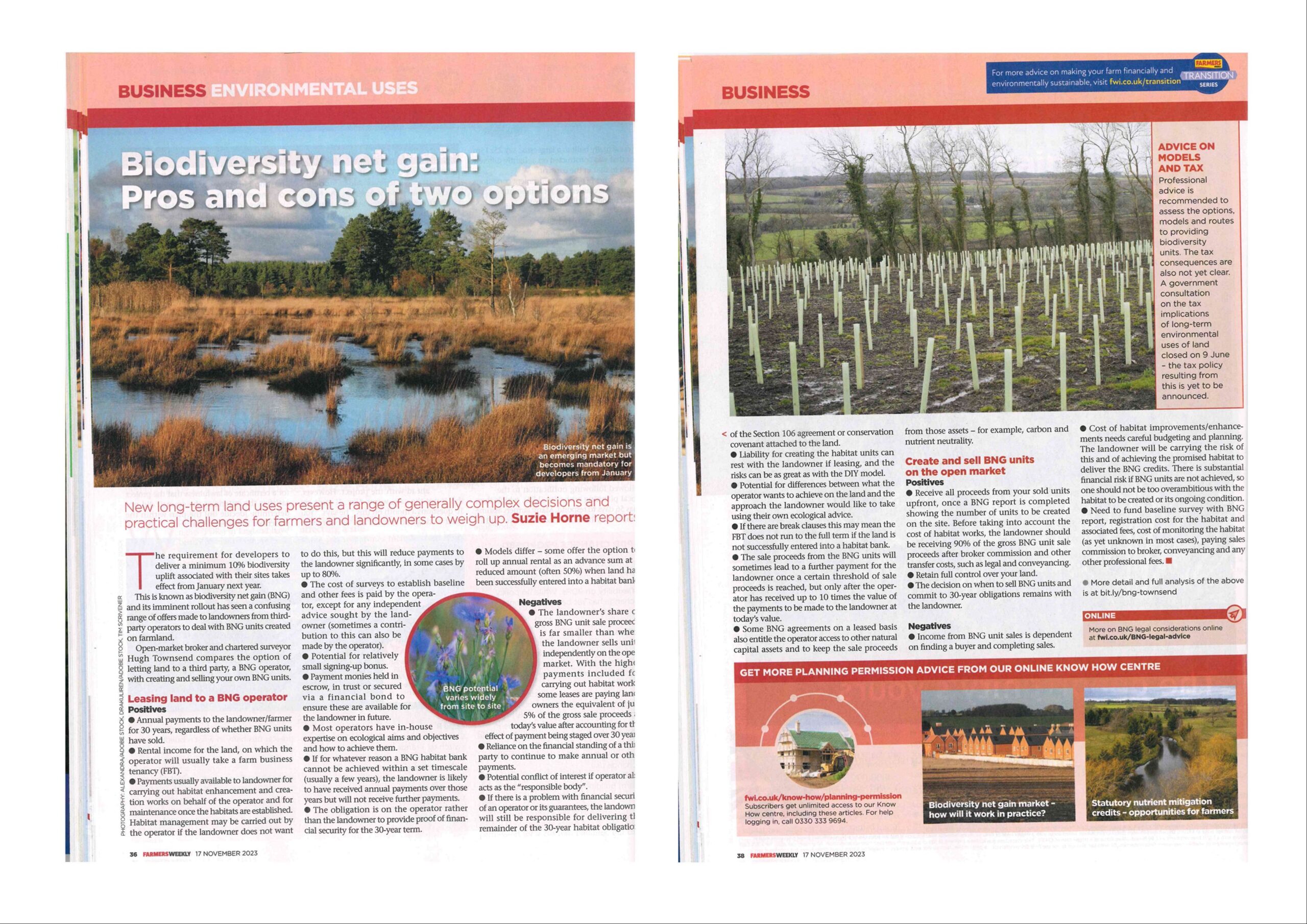The requirement for developers to deliver a minimum 10% biodiversity uplift associated with their sites takes effect from January next year.
This is known as biodiversity net gain (BNG) and its imminent roll out has seen a confusing range of offers made to landowners from third-party operators to deal with BNG units created on farmland.
Open-market broker and chartered surveyor Hugh Townsend compares the option of letting land to a third party, a BNG operator, with creating and selling your own BNG units.

Leasing land to a BNG operator
Positives
- Annual payments to landowner/farmer for 30 years regardless of whether BNG units have sold.
- Rental income for land on which the operator will usually take a farm business tenancy (FBT).
- Payments usually available to landowner for carrying out habitat enhancement and creation works on behalf of the operator and for maintenance once the habitats are established.
- Habitat management may be carried out by the operator if the landowner does not want to do this but this will reduce payments to the landowner significantly, in some cases by up to 80%.
- Costs of surveys to establish baseline, and other fees paid for by operator other than for any independent advice sought by the landowner (sometimes a contribution to this can also be made by the operator).
- Potential for relatively small signing-up bonus.
- Payment monies held in escrow, in trust or secured via a financial bond to ensure these are available for the landowner in future.
- Most operators have in-house expertise on ecological aims and objectives and howto achieve them.
- If for whatever reason a BNG habitat bank cannot be achieved within a set timescale (usually a few years), the landowner is likely to have received annual payments over those years but will not receive further payments.
- The obligation is on the operator rather than the landowner to provide proof of financial security for the 30-year term.
- Models differ – some offer the option to roll up annual rental as an advance sum at a reduced amount (often 50%) when land has been successfully entered into a habitat bank.
Negatives
- Landowner’s share of gross BNG unit sale proceeds is far smaller than when the landowner sells units independently on the open market. With the higher payments included for carrying out habitat works, some leases are paying landowners the equivalent of just 5% of the gross sale proceeds at today’s value after accounting for the effect of payment being staged over 30 years.
- Reliance on the financial standing of a third party to continue to make annual or other payments.
- Potential conflict of interest if operator also acts as the “responsible body”.
- If there is a problem with financial security of an operator or its guarantees, the landowner will still be responsible for delivering the remainder of the 30-year habitat obligations of the Section 106 agreement or conservation covenant attached to the land.
- Liability for creating the habitat units can rest with the landowner if leasing and the risks can be as great as with the do-it-yourself model.
- Potential for differences between what the operator wants to achieve on the land and the approach the landowner would like to take using their own ecological advice.
- If there are break clauses this may mean the FBT does not run to the full term if the land is not successfully entered into a habitat bank.
- The sale proceeds from the BNG units will sometimes lead to a further payment for the landowner once a certain threshold of sale proceeds is reached, but only after the operator has received up to 10 times the value of the payments to be made to the landowner at today’s value.
- Some BNG agreements on a leased basis also entitle the operator access to other natural capital assets and to keep the sale proceeds from those assets – for example, carbon and nutrient neutrality.
Create and sell BNG units on open market
Positives
- Receive all proceeds from your sold units upfront, once a BNG report is completed showing the number of units to be created on the site. Before taking into account the cost of habitat works, the landowner should be receiving 90% of the gross BNG unit sale proceeds after broker commission and other transfer costs, such as legal and conveyancing.
- Retain full control over your land.
- Decision when to sell units and commit to 30-year obligations remains with landowner.
Negatives
- Income from BNG unit sales is dependent on finding a buyer and completing sales.
- Cost of habitat improvements/enhancements needs careful budgeting and planning. The landowner will be carrying the risk of this and of achieving the promised habitat to deliver the BNG credits. There is substantial financial risk if BNG units are not achieved, so one should not be too over-ambitious with the habitat to be created or its ongoing condition.
- Need to fund baseline survey, with BNG report, registration cost for the habitat and associated fees, cost of monitoring the habitat (as yet unknown in most cases)paying sales commission to broker, conveyancing and any other professional fees.
| Advice on models and tax |
| Professional advice is recommended to assess the options, models and routes to providing biodiversity units. The tax consequences are also not yet clear.A government consultation on the tax implications of long-term environmental uses of land closed on 9 June – the tax policy resulting from this is yet to be announced. |
Download/view article here
